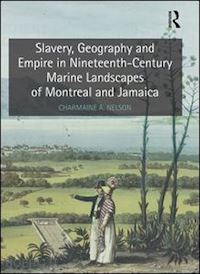List of Illustrations Acknowledgments Introduction Slavery studies and its absences Contesting the erasure of black Canada and Canadian slavery Postcolonial geography: Understanding landscapes as racialized The case of two islands: Comparing Montreal and Jamaica Societies-with-slaves vs. slave societies Montreal and Jamaica: Colonized landscapes The chapters Terminology 1 Colonialism and art: Landscape and empire Critical geography and art history: Of landscape representation, imperialism, and power Art-making as empire-making: Whiteness, travel, and imperial vision Montreal and Jamaica: Imperial connections Transoceanic art Maps, landscape painting, and topographical ,landscapes 2 A tale of two empires: Montreal slavery under the French and the British A transition of power: From French to British slavery Liminal bodies: "Loose" women, drunken soldiers, and vagrancy Adapting slavery under the British Situating Montreal’s black minority The face of slave ownership in Montreal: James McGill 3 Representing the enslaved African in Montreal Portraiture and slavery Geographical alienation and the hierarchy of enslavement Marie-Thérèse-Zémire, revolutionary St. Domingue, and the politics of flight Critiquing Canadian museum practice: The Montreal Museum of Fine Arts’ installation of Portrait of a Haitian Woman The conditions of African enslavement in eighteenth-century Montreal and St. Domingue Life after François: "Portrait" of a Montreal slave mistress Minuets of the Canadians and African Cultural Survivals The tambourine Connecting black Canadian music to the African diaspora 4 Landscaping Montreal Montreal as British Military Stronghold Re-Imagining Montreal as a Colonial Trade and Slave Port St. Helen’s Island 5 Landscaping Jamaica John Seller’s Atlas Maritimus: Jamaica in the early modern British imagination Sloane’s natural history The Beckfordesque landscape tradition Beckford, slavery, and sugar cultivation The picturesque and Beckford’s debt to European landscape (painting) The planter’s vantage point: The tropical picturesque 6 Imaging slavery in Antigua and Jamaica: Pro-slavery discourse and the reality of enslavement William Clark’s Antigua The tropical picturesque as pro-slavery discourse Thomas Thistlewood and Vineyard Pen White male sexual exploitation of black women Thomas Thistlewood, Agostino Brunias, and cross-racial sexual relations in the Caribbean The price of excess: white male promiscuity and the spread of venereal disease The state of Jamaican slavery 7 James Hakewill’s Picturesque Tour: Representing life on nineteenth-century Jamaican sugar plantations Sugar cane or slaves: Representing and sublimating labour William Clark’s labouring slaves Animalizing slaves, humanizing animals James Hakewill’s white women "I am the Only Woman": Politeness and the erasure of black and coloured women Riding side-saddle: White femininity, modernity, and privilege 8 Beyond Sugar: James Hakewill’s vision of Jamaican settlements, livestock pens, and the spaces between Caretaking animals: Identity and penkeeping The limits of mobility and the pervasiveness of surveillance: Exploring wainage "Other" whites: Representing British soldiers in the Caribbean White anxiety: Cross-racial mixing and coloured populations Conclusion: Deception in the life and art of the white Jamaican creole planter class












